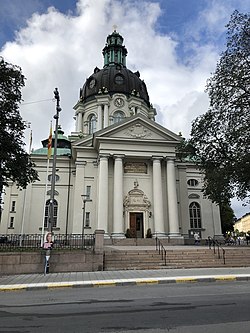
Stockholm Palace or the Royal Palace is the official residence and major royal palace of the Swedish monarch. Stockholm Palace is on Stadsholmen, in Gamla stan in the capital, Stockholm. It neighbours the Riksdag building. The offices of the King, the other members of the Swedish royal family, and the Royal Court of Sweden are here. The palace is used for representative purposes by the King whilst performing his duties as the head of state.

The Drottningholm Palace is the private residence of the Swedish royal family. Drottningholm is near the capital Stockholm. Built on the island Lovön, it is one of Sweden's Royal Palaces. It was originally built in the late 17th century, and it served as a regular summer residence of the Swedish royal court for most of the 18th century. Apart from being the private residence of the Swedish royal family, the palace is a popular tourist attraction.

Stockholm City Hall is the seat of Stockholm Municipality in Stockholm, Sweden. It stands on the eastern tip of Kungsholmen island, next to Riddarfjärden's northern shore and facing the islands of Riddarholmen and Södermalm. It houses offices and conference rooms as well as ceremonial halls. It is the venue of the Nobel Prize banquet and is one of Stockholm's major tourist attractions.

Uppsala Cathedral is a cathedral located between the University Hall of Uppsala University and the Fyris river in the centre of Uppsala, Sweden. A church of the Church of Sweden, the national church, in the Lutheran tradition, Uppsala Cathedral is the seat of the Archbishop of Uppsala, the primate of Sweden. It is also the burial site of King Eric IX, who became the patron saint of the nation, and it was the traditional location for the coronation of new Kings of Sweden.

The Swedish History Museum is a museum located in Stockholm, Sweden, that covers Swedish archaeology and cultural history from the Mesolithic period to present day. Founded in 1866, it operates as a government agency and is tasked with preserving Swedish historical items as well as making knowledge about history available to the public.

Storkyrkan, also called Stockholms domkyrka and Sankt Nikolai kyrka, is the oldest church in Stockholm. Storkyrkan lies in the centre of Stockholm in Gamla stan, between Stockholm Palace and Stortorget, the old main square of Stockholm. It was consecrated to Saint Nicholas in 1306 but construction of the church probably started in the 13th century. Inside, Storkyrkan still maintains much of its late medieval appearance in the form of a hall church with a vaulted ceiling supported by brick pillars. The exterior of the church is however uniformly Baroque in appearance, the result of extensive changes made in the 18th century. The church played an important role during the Reformation in Sweden as the place where Mass was celebrated in Swedish for the first time. It currently serves as the seat of the Bishop of Stockholm within the Church of Sweden since the creation of the Diocese of Stockholm in 1942.

The Frauenkirche is a church in Munich, Bavaria, Germany, that serves as the cathedral of the Archdiocese of Munich and Freising and seat of its Archbishop. It is a landmark and is considered a symbol of the Bavarian capital city. Although called "Münchner Dom" on its website and URL, the church is referred to as "Frauenkirche" by locals.

The Theatine Church of St. Cajetan and Adelaide is a Catholic church in Munich, southern Germany. Built from 1663 to 1690, it was founded by Elector Ferdinand Maria and his wife, Henriette Adelaide of Savoy, as a gesture of thanks for the birth of the long-awaited heir to the Bavarian crown, Prince Max Emanuel, in 1662. Now administered by the Dominican Friars, it is also known as the Dominican Priory of St. Cajetan.
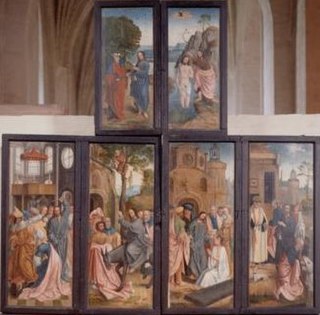
Västerås Cathedral is the seat of the Diocese of Västerås in the Province of Västmanland, Sweden. The church building is a five-tiered cathedral, with copper-covered roof as well as a west tower with side extensions and an obelisk-shaped, copper-clad spire. It is built in the Scandinavian Brick Gothic style.

Swedish art refers to the visual arts produced in Sweden or by Swedish artists. Sweden has existed as a country for over 1,000 years, and for times before this, as well as many subsequent periods, Swedish art is usually considered as part of the wider Nordic art of Scandinavia. It has, especially since about 1100, been strongly influenced by wider trends in European art. After World War II, the influence of the United States strengthened substantially. Due to generous art subsidies, contemporary Swedish art has a big production per capita.

Slottsbacken is a street in Gamla stan, the old town in central Stockholm, Sweden.

Saint James's Church is a church in central Stockholm, Sweden, dedicated to apostle Saint James the Greater, patron saint of travellers. It is often mistakenly called St Jacob's. The confusion arises because Swedish, like many other languages, uses the same name for both James and Jacob.

The Mannheim Jesuit Church is a Catholic church of historic and artistic importance in Mannheim, Germany. Church construction was begun in 1733 and completed in 1760. It was consecrated to St. Ignatius of Loyola and St. Francis Xavier. During the Second World War, the church suffered severe damage from air attacks; after the war it was rebuilt in its historical style using original parts.
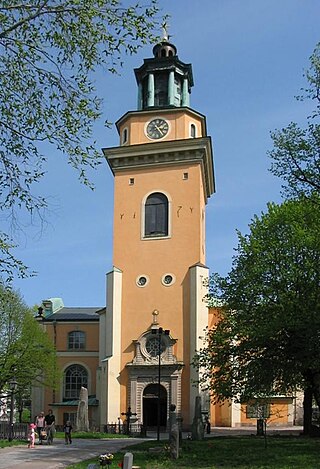
The Church of Saint Mary Magdalene is a church on Södermalm in central Stockholm, Sweden, dedicated to and named for Jesus' companion Mary Magdalene.
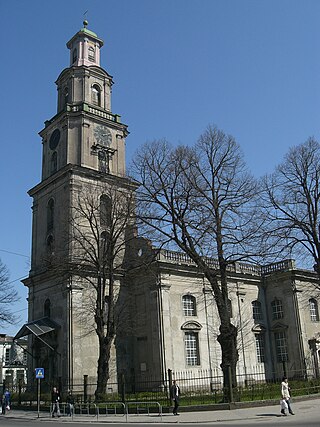
Liepāja Holy Trinity Lutheran Cathedral is a historical Lutheran cathedral in Liepāja, Latvia. It is the seat of the Bishop of Liepāja, and principal church of the Diocese of Liepāja.
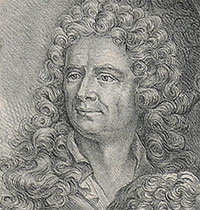
Burchard Precht was a Swedish-German furniture maker and sculptor. He is best known for his contributions to Stockholm Cathedral and Uppsala Cathedral; he designed the altarpiece for Uppsala in 1728. Precht and his workshop also created other church furnishings, including epitaphs, and a large amount of furniture, primarily gilded tables, guéridons and ornamental frames for mirrors and pictures.

Engelbrekt Church is a protected church located in the Lärkstaden area of Stockholm, Sweden. Its located at Östermalm and belongs to the Church of Sweden and is parish church for Engelbrekt Parish in the Diocese of Stockholm. It was designed by architect Lars Israel Wahlman in the National Romantic style and completed in 1914. It is one of the largest churches in Stockholm, with 1,400 seats.
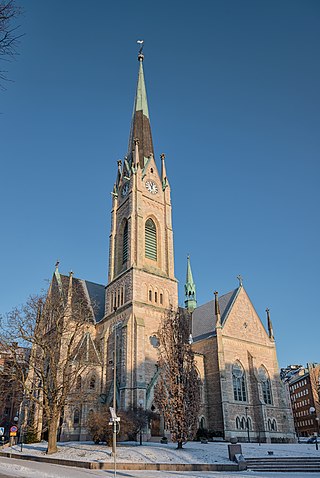
Oscar's Church is one of the major churches in Stockholm, Sweden. The three-aisled hall church, which holds 1,200 people, has an 80-metre-high (260 ft) tower in the south-western part of the building. Oscar's Church is located in the south-eastern part of Östermalm, where Storgatan and Narvavägen meet, near the Swedish History Museum. Narvavägen is together with the nearby Strandvägen—from which the church is also visible—one of the city's main boulevards, lined with several residential palaces.
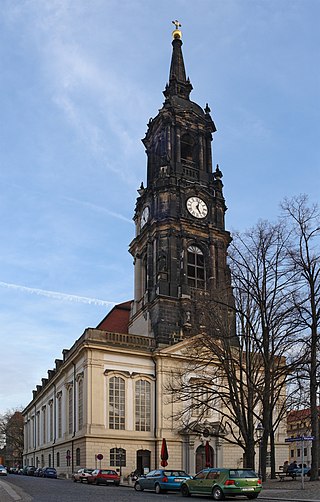
The Dreikönigskirche is a Lutheran church located in the Innere Neustadt of Dresden, Germany. It is the centre of a parish, and a community venue called Haus der Kirche. The church is a listed cultural monument of Dresden.

Ekenäs Church is a 17th century neoclassical stone church located in Ekenäs in the Finnish town of Raseborg. The construction of the church was started in 1651 and carried out to the 1670s. The initiative to build a stone church in Ekenäs came from earl Gustaf Adolf Leijonhufvud but it is unknown who designed the original baroque church.
